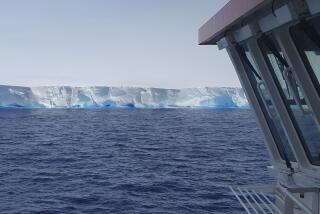Global Voyage Collects a World of Science : Research: U.S. vessel’s trip took 11 months and brought back information on climate and wildlife. The data may help everyone from farmers to swimsuit manufacturers.
- Share via
MIAMI — As a monsoon raged on the surface of the Indian Ocean, scientists aboard a U.S. research vessel clung to their equipment.
Waves tore at the listing ship but--30,000 feet below the swells--the work went on.
Gauges from the ship lowered into the ocean’s depths recorded data that will be used to help forecast floods, droughts and hurricanes. The information could even determine whether Peruvian farmers should plant cotton or rice next year.
The Malcolm Baldrige, a 278-foot National Oceanic and Atmospheric Administration research ship, returned here recently after circumnavigating the globe on a mission that lasted 11 months and covered 58,000 nautical miles.
Scientists traveled to half a dozen countries and collected data on everything from the temperature, salinity and currents of the ocean to marine mammal life and the ocean’s effects on global warming.
Their findings could affect the way farmers, insurance companies, even swimsuit manufacturers conduct business, Navy Capt. Craig Nelson said.
“We have got to get that message across that there are societal and economic consequences to the forecasts that we do,” Nelson said.
One tool used by meteorologists in predicting the severity and frequency of rain storms, hurricanes and other weather systems is El Nino, a periodic ocean-warming phenomenon. Hurricane seasons, for example, are relatively mild during an El Nino year.
To know when an El Nino year is coming, scientists study temperatures and currents of the Pacific Ocean. That data is collected by 63 buoys maintained by the NOAA.
“People can benefit from knowing that an El Nino is going to occur,” said Nelson, a physical oceanographer and meteorologist.
“If you’re a swimsuit manufacturer and you find out there’s a 60% probability it’s going to be much colder than normal in the summer, you’re not going to go into production and make twice as many swimsuits as last year.”
El Nino years are typically good for fishing and relatively dry. The Peruvian government looks to the forecasts and plans its agricultural interests accordingly, Nelson said.
“Rice survives just fine in a wet season--cotton doesn’t do as well,” he said.
But, Nelson said, the practical applications of NOAA’s work have not been as well realized in the United States. Nelson hopes that will be changed by increased education and news coverage of El Nino.
In addition to taking ocean readings, teams of scientists joined the 25-year-old ship and conducted their own studies of marine mammal life and ozone depletion above the Indian Ocean. It was the first round-the-globe trip for an NOAA vessel.
The Indian Ocean, for example, was largely unexplored and undocumented before this year, for example. Nelson said the data collected during the last few months will serve as a basis for comparison in the future.
After departing Feb. 13, 1995, from Miami, the Malcolm Baldrige traveled to Puerto Rico and Ascension Island. It later stopped at Oman and several islands off the eastern coast of Africa. It then traveled to Australia, American Samoa, back through the Panama Canal into Miami, which had been its home base until the end of January, when it relocated to Charleston, S.C.
Despite the length of the journey and the threat of monsoons and other weather perils, the team of 50 crew members and between two and 30 scientists survived the expedition nearly unscathed, Ensign Mark Wetzler said. The number of scientists varied with how many were carrying out experiments at any one time.
On one occasion, though, winds reached 35 to 40 knots and the seas were about 30 feet. The ship rolled 35 degrees, and a life raft--normally about 30 feet off the sea’s surface--was torn from the side of the ship. Luckily, no one was injured, but the group had to abandon their testing.
“I changed course,” Wetzler said, shaking his head at the memory. “I didn’t even ask the captain for permission.”





